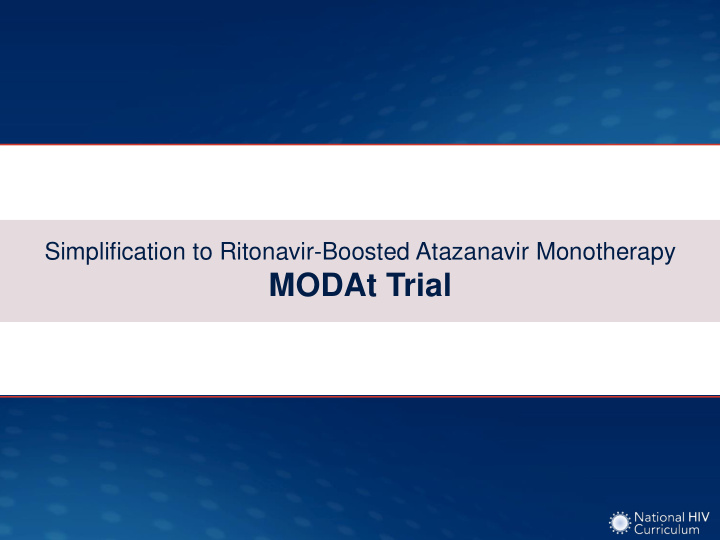



Simplification to Ritonavir-Boosted Atazanavir Monotherapy MODAt Trial
Simplification to Ritonavir-Boosted Atazanavir Monotherapy MODAt: Study Design Study Design: MODAt • Background : Randomized, open-label noninferiority trial in adults with virologically suppressed HIV infection to evaluate the efficacy of simplification to Monotherapy Group once-daily ritonavir-boosted atazanavir monotherapy Ritonavir-boosted Atazanavir versus continuing once-daily ritonavir-boosted (n = 51) atazanavir with two NRTIs • Inclusion Criteria (n = 103) - Age ≥18 - On atazanavir + ritonavir + 2 NRTIs for ≥48 weeks Triple Therapy Group Ritonavir-boosted - HIV RNA <50 copies/ml for ≥ 24 weeks Atazanavir+ 2 NRTIs - CD4 nadir ≥100 cells/mm 3 (n = 52) - No previous virologic failure • Treatment Arms - Atazanavir 300 mg + Ritonavir 100 mg once daily - Atazanavir 300 mg + Ritonavir 100 mg once daily + 2 NRTIs Source: Castagna A, et al. AIDS. 2014;28:2269-79.
Simplification to Ritonavir-Boosted Atazanavir Monotherapy MODAt: Results Week 48: Virologic Response by HIV RNA (ITT, re-intensification=failure) Atazanavir/r Monotherapy Atazanavir/r + 2 NRTIs 100 93 Virologic Efficacy (%) 80 85 81 75 73 70 60 40 20 0 ≤ 100,000 copies/mL All > 100,000 copies/mL Baseline HIV RNA Source: Castagna A, et al. AIDS. 2014;28:2269-79.
Simplification to Atazanavir/r Monotherapy MODAt: Results Week 48: Virologic Response by HIV RNA (ITT, re-intensification=success) Atazanvir/r monotherapy Atazanavir/r + 2 NRTIs 100 96 93 92 89 80 Virologic Efficacy (%) 85 81 60 40 20 0 ≤ 100,000 copies/mL All > 100,000 copies/ml Baseline HIV RNA Source: Castagna A, et al. AIDS. 2014;28:2269-79.
Simplification to Ritonavir-Boosted Atazanavir Monotherapy MODAt: Conclusions Conclusion : “ATV/r monotherapy treatment simplification showed lower virological efficacy in comparison with maintaining triple therapy; NRTIs reintroduction was effective in all the individuals.” Source: Castagna A, et al. AIDS. 2014;28:2269-79.
Acknowledgment The National HIV Curriculum is an AIDS Education and Training Center (AETC) Program resource funded by the United States Health Resources and Services Administration. The project is led by the University of Washington and the AETC National Coordinating Resource Center. The content in this slide set does not represent the official views of the U.S. Department of Health and Human Services, Health Resources & Services Administration.
Recommend
More recommend